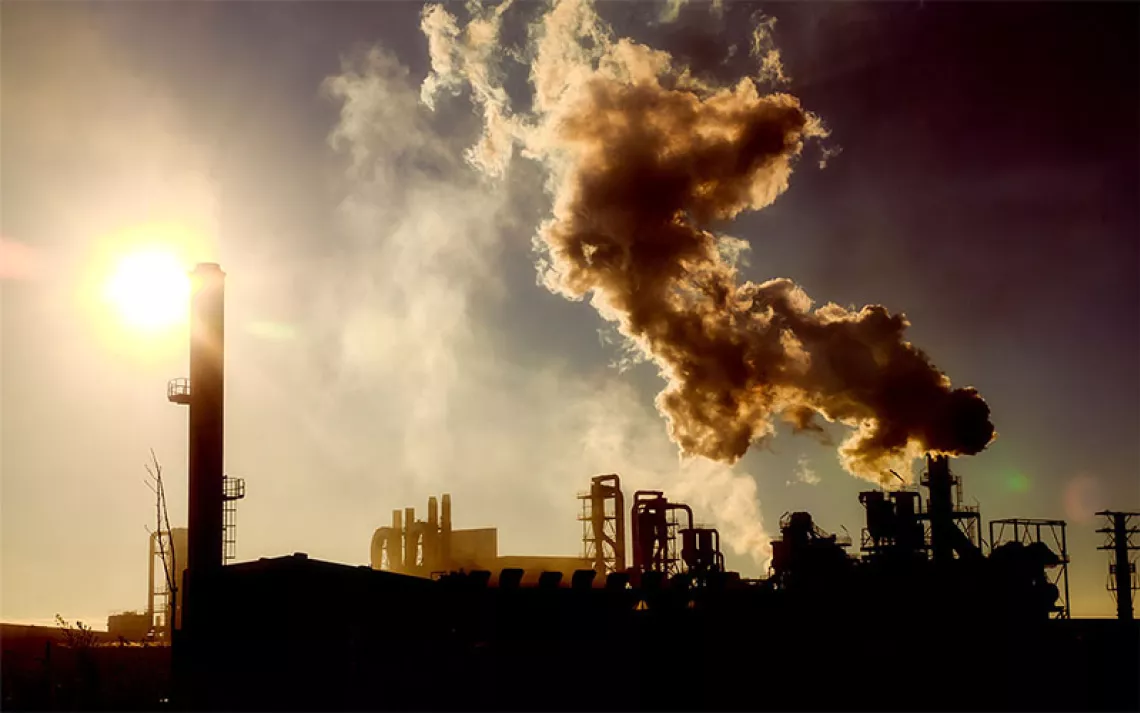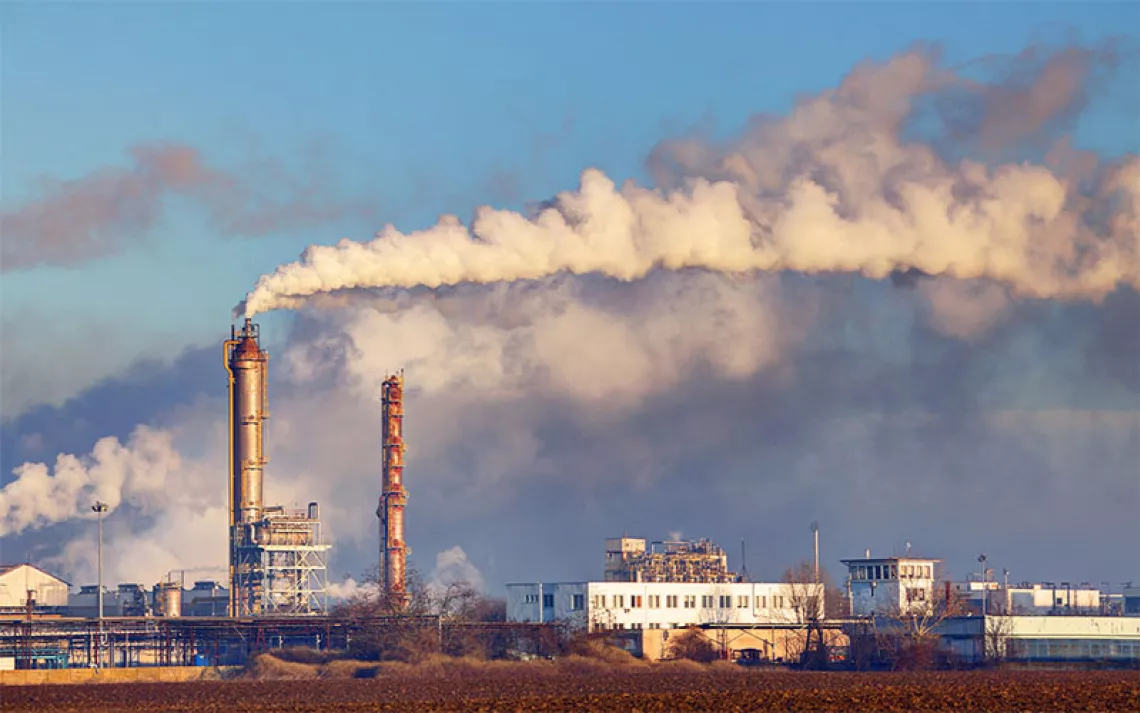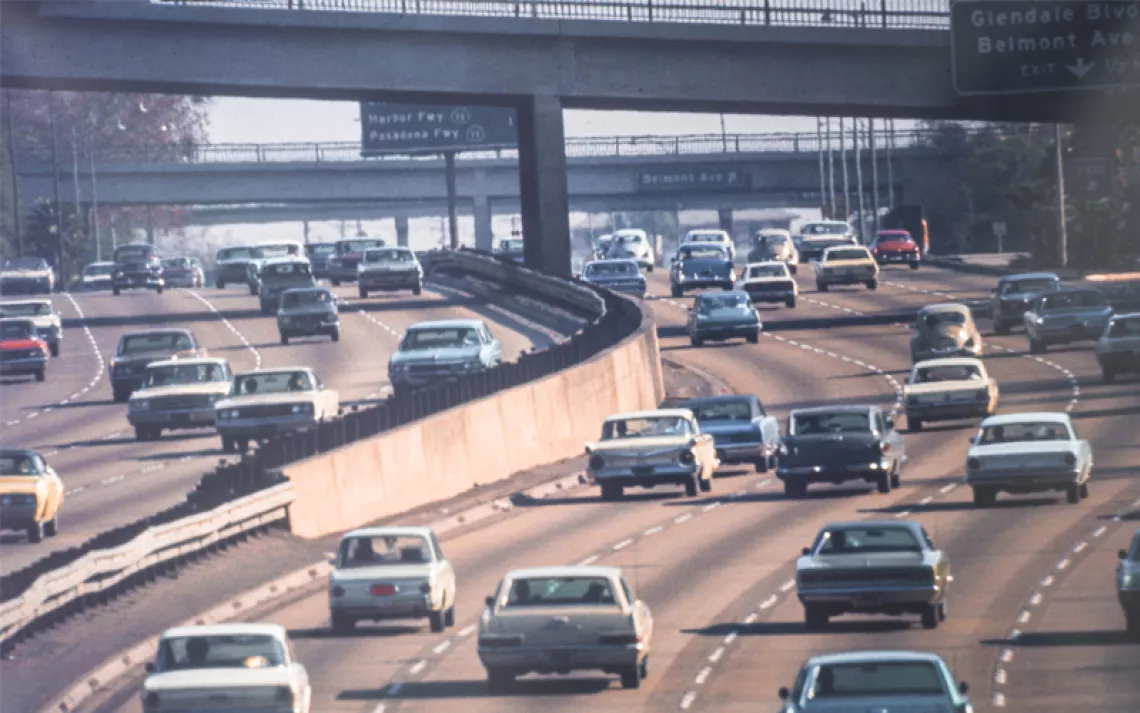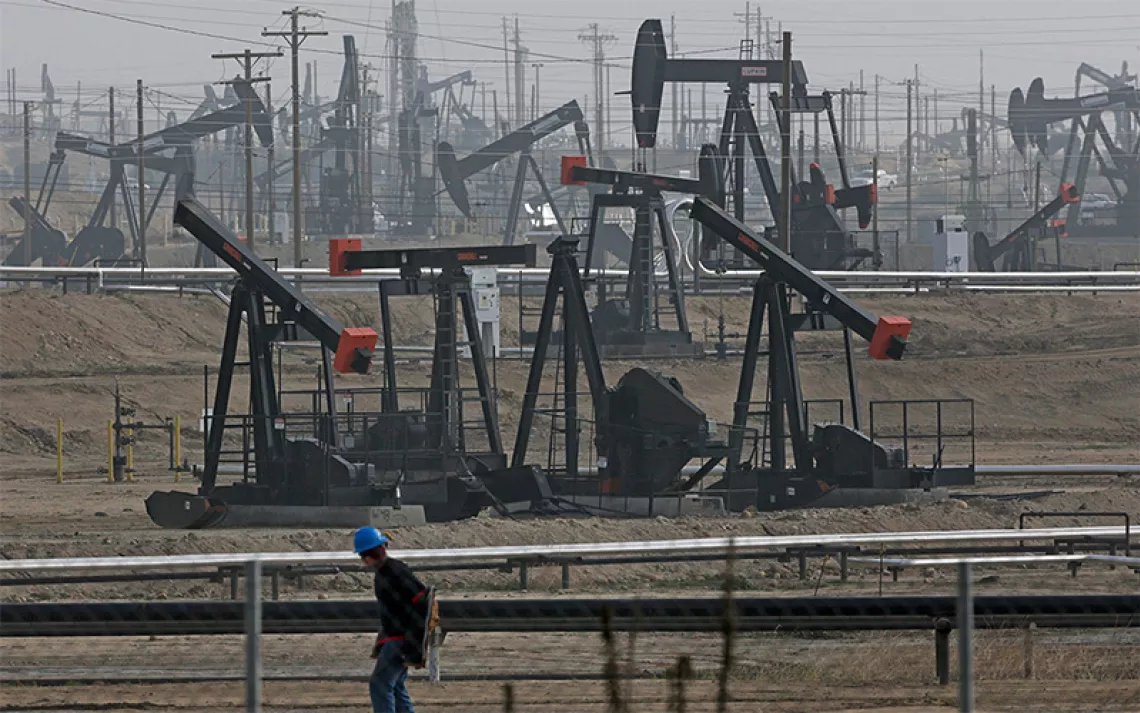Moving From “Flight Shame” to Flight Solutions
Why climate-obsessed travelers should ditch the guilt and support efforts to cut aviation's carbon footprint

Photo by amriphoto/iStock
Let me start with a confession: I am addicted to travel. Many of my most vibrant memories involve having the enormous privilege to explore amazing places around the world. Seeing musk oxen and caribou on the Arctic tundra and hearing Indigenous elders talk about the ways their lives are tied to the seasonal migrations. Experiencing the awe of a mountain cathedral, a desert canyon, or a wilderness river. Gaining insights into vibrant cultures that remind me that our car-dependent, post-industrial society is only one way to live, and not necessarily the best. Visiting family and close friends around the nation and the world. Sharing meals, swapping stories, and laughing with fellow activists. These experiences are impossible to replicate fully in a virtual world and are not things I would give up lightly.
I suspect many of you feel the same way. Sierra Club’s mission is to “explore, enjoy, and protect the wild places of the earth,” and thousands take part in our national and international outings each year. For many of us, the passion that drives us to protect this precious planet is kindled and periodically refreshed by our opportunities to explore and enjoy its many special places.
So why talk about my passion for travel as an addiction? The answer should be obvious: if you are concerned about the climate crisis, the emissions created by jet travel are a large and growing issue. While aviation currently only represents approximately 2 to 3 percent of global carbon emissions, its share is growing rapidly as more people have the resources to travel and as sectors that are easier to decarbonize are repowered with clean electricity. For many of us with the privilege and resources to travel, flying represents the largest part of our personal emissions footprint.
For many climate activists, the solution seems simple: Just stop flying. That’s the recommendation in a feature article in this month’s Sierra, which concludes that the only real fix for aviation’s climate and environmental impact is for people to stay on the ground. Over the past several years, the concept of “flight shame”—“flygskam” in Swedish where the movement began—has been gaining traction. The most famous proponent is the young climate champion Greta Thunberg, who famously traveled to and through the Americas by sailing yacht and in a Tesla. In Europe, flight shaming has also given rise to “train bragging,” as travelers share stories about overland voyages. Solutions for aviation’s climate impact are hard and will be slow coming, the argument goes, so we all just need to stay at home or jump on a bus or train instead. (It’s worth noting, though, that taking a bus from coast to coast burns roughly the same amount of carbon as flying a direct flight.)
I applaud anyone who wants to eliminate or reduce their flying habit. I find enormous joy exploring my backyard mountains and forests. Many times there are better alternatives to hopping on a jet. The pandemic exposed us all to technologies and practices that provide alternatives to many work trips. And lots of trips can be better done on the ground. The CEO of KLM recently encouraged customers to stop flying short routes in Europe, and France moved to ban domestic flights that are better served by train. We all should advocate for the kind of train system in the US that makes so many trips more convenient in other places.
There are at least three problems, however, with the argument that the only solution for aviation’s climate problem is to stop flying. First, this approach puts the burden on individuals, rather than accelerating the systems changes that will cut carbon from flight. Second, this approach simply won’t scale. Flying is a large and growing sector, and we live in a diverse, interconnected, and increasingly mobile world. Even if you can convince some small percentage of Sierra readers to kick their flying habit, it will be a proverbial drop in the bucket to the continued growth of aviation as the global economy recovers from the recent pandemic. Hair shirts are always niche products that don’t appeal to mass audiences. Finally, while solutions for aviation’s climate footprint are challenging, they do exist and need to be scaled rapidly. Rather than encouraging people to turn their backs on jet travel and shame those who fly, we need to support the kinds of policies and investments that will allow fossil-fuel-free travel.
Let’s take these one at a time.
We need to change systems, not shame people for how they live
It’s worth remembering who first popularized the idea of personal “carbon footprints”: PR flacks for British Petroleum. At the time, they were working to shift responsibility for the climate crisis away from fossil fuel companies and corporate polluters and onto the backs of consumers who are trying to get on with living their lives within the systems that big business has created. Our opponents love to point out examples of “hypocrisy,” such as people driving or flying to a climate action or protesting fossil fuels expansion in a plastic kayak. As Alanna Schubach writes in The Nation.
There’s a lot of pressure on Americans to make virtuous, self-abnegating choices. Don’t use plastic straws; don’t eat meat; don’t fly anywhere; don’t have children: These imperatives all have something in common. They place the burden of solving climate change squarely on the shoulders of ordinary people. They imply that unless we decline to do things that might bring us great joy—like start a family, or experience the world beyond our own borders—we are responsible for the destruction of the planet.
Suggesting that the only solution for aviation’s climate problem is for people who care about a liveable planet to stop flying puts the burden on individuals and excuses industry from the need to develop real solutions.
These types of demands divert attention from the fossil fuel companies, investors, and politicians who are perpetuating the systems causing global harm. Calls for purity and shaming exclude people and narrow our coalition at a time when we desperately need more people demanding climate action. And psychologists have documented that shaming personal behaviors can lead to the “what the hell” effect, where people conclude that if they can’t live up to an impossible standard, they will just indulge as much as they want.
The pandemic also brought focus on our human need for personal contact. We are social animals, and the glue that holds any group together comes from personal contacts and mutual respect. I should mention that I am writing this while flying back from a meeting with Sierra Club’s volunteer and staff leaders—one of our first in-person gatherings since Covid forced us to suspend travel. We all learned a lot during the pandemic about ways we can use Zoom and other virtual tools effectively to conduct a lot of our work, and I expect we will be flying less than in the “before times.” And typing these lines while crammed in the last seat in coach reminds me that while participating in a meeting from my home office is far more comfortable and much less disruptive than experiencing the dubious “joys” of air travel, it never is a complete substitute. I am hating the flight but energized by our time together, getting to know other leaders as people, sharing meals, taking walks, and strategizing about how we can supercharge climate action in every state in the country. Periodic face time is essential to forming effective and resilient teams that can work together to confront our biggest challenges.
None of this suggests that people shouldn’t be conscious of personal choices and try to find ways to cut wasteful habits. Nobody needs to fly on private jets, or use helicopters for errands. But suggesting that the only solution for aviation’s climate problem is for people who care about a livable planet to stop flying puts the burden on individuals and excuses industry from the need to develop real solutions.
This does not mean that climate activists should simply accept unchecked growth for aviation or that we should sit idly by when planners tell us we need a new airport or runways.
Flight shaming won’t stop aviation’s growth
Global air traffic has been on a dramatic growth curve over the past decades, especially in rapidly developing economies where flying was once a luxury reserved for a privileged few. Most experts are forecasting aviation to recover from the setback caused by the pandemic within the next year and continue growing at an annual rate of 2.7 percent to over 4 percent through 2050. The demand for flying has been particularly strong in places like Brazil, Africa, and Asia, as more people have access to travel and as families are increasingly spread across the globe.
Let me be clear: This does not mean that climate activists should simply accept unchecked growth for aviation or that we should sit idly by when planners tell us we need a new airport or runways. Building new airports can increase the demand, in the same way that widening highways always results in more traffic. In my own backyard, Sierra Club has joined with other groups to push back on claims that the Seattle region needs a new airport, scrutinizing industry growth projections and demanding that authorities fully analyze the climate and other impacts from new or expanded airports. We should advocate for investments in cleaner mobility, cleaner fuels, and other solutions as conditions before allowing any new capacity to be built. We should also demand policies that constrain growth and address the true costs of aviation, especially for the most wasteful types of flying, such as private jets, same day delivery of luxury goods, and reviving supersonic flight.
All these efforts are important. At best they will only slow aviation’s growth, however, and provide leverage to demand investments and policy support for other solutions. Barring a massive economic collapse or global plague, it is wildly implausible to think aviation is going to disappear and hard to envision any circumstances in which jet travel doesn’t continue to grow and remain a major source of pollution over the coming decades. According to a study this year in Nature, even the most heroic measures to suppress demand will still result in global growth of around 1 percent annually (down from a “business as usual” scenario, which would see flights tripling by 2050). Since people will continue flying, we need to demand and support lower-carbon and sustainable solutions.
Moving from flight shame to real solutions for aviation
So what can we do to cut climate pollution from jet travel? In addition to finding ways to get people to fly less (discussed above), the solutions fall into two primary “buckets”: 1) reducing fuel burn by building more efficient jets and rerouting flights and 2) changing the fuels and energy that propels planes. I am not counting offsets as a real or viable solution for aviation’s climate problem. Although many airlines offer travelers the chance to travel guilt-free by buying credits to support projects that are supposed to cut emissions or suck up carbon elsewhere, many studies have shown massive problems with the claimed benefits from these projects. A California consumer even recently sued Delta for “greenwashing,” arguing that their claims to be on a path toward “carbon neutral flight” were underpinned by dubious offsets. Real solutions for aviation, as with any sector, need to come by finding cleaner ways to fly.
Improving efficiency
The good news is that the industry has made great strides in cutting the amount of fuel needed to fly. Unlike the automobile industry, which has used slick advertising to convince us we really need gas-guzzling pickups and SUVs as symbols of our status and identity, aircraft and engine manufacturers respond to the needs of their airline customers, who are driven purely by economics. Since fuel is their biggest and most volatile operating expense, their dominant concern when they pick a new plane is finding one that will use the least possible fuel per passenger mile. As a result, commercial jets today sip around 70 percent less fuel than the planes produced 40 years ago, and aircraft and engine makers pour huge amounts of their R&D expenditures into finding ways to continue to cut that fuel use with each new model. Meanwhile airlines have increased their operational efficiency by routing more direct flights, changing approach and landing paths, and taking other steps to cut fuel burn.
Great news, right? Unfortunately, the same improvements that have dramatically cut fuel use per flight have also allowed airlines to offer those flights at lower costs resulting in … many more people flying, more fuel burned, and more carbon in the atmosphere. For my fellow energy nerds, this hamster-on-a-wheel phenomena where efficiency gains often result in greater use of the very thing you are trying to use less of is sometimes referred to as Jevons paradox. In plain terms, this just means that while efficiency improvements are helpful, we can’t count on them to significantly reduce aviation’s climate problem.
Ditching fossil fuels for cleaner energy
The biggest focus for cutting aviation’s climate footprint, then, needs to be on replacing fossil fuels with cleaner forms of energy that will work in commercial planes. We need to look at these solutions both in the short and longer term. If we want to reduce pollution significantly before 2050—a time frame that scientists and activists agree is critical to averting the worst impacts of the climate crisis—we will need a massive scale-up of lower-carbon, sustainable fuels that can replace petroleum fuels in existing jets and the ones that continue to roll off assembly lines. In the longer term, solutions may involve totally different kinds of planes powered by new energy sources, such as hydrogen or electricity. Engineers who are a lot smarter than me are working on what the future of aviation might look like—for now I am going to focus on what we need to do in the next several decades.
Sustainable aviation fuels are critical for near-term reductions
Nearly all analysts agree that sustainable aviation fuels (SAFs) are critical for cutting aviation’s climate footprint in the next several decades.
So what are SAFs? Essentially, this term refers to drop-in, energy-dense fuels that can be burned in existing jet engines and are low-carbon and meet other sustainability criteria. Unlike first-generation biofuels, SAFs have the same basic chemical makeup as the fossil-jet they are replacing, and they can be refined from a wide variety of renewable feedstocks.
To qualify as SAFs, fuels need to have life-cycle emissions that are significantly lower than the fossil-based fuels that they are replacing—at least 50 percent better according to the US Department of Energy. The emissions factors can vary widely for alternative fuels, and policies should promote options that provide the greatest reductions in climate pollution accounting for all the factors, including any direct or indirect land-use impacts from growing the feedstocks.
It is also important to ensure that SAFs are in fact sustainable. A global NGO, the Roundtable for Sustainable Biomaterials, has created a set of criteria that have been embraced by leading SAF producers, purchasers, and advocacy groups to evaluate potential fuels. This standard includes critical issues like food security, human rights, conservation, and air and water quality as issues that need to be addressed, in addition to cutting climate pollution.
Based on these factors, most advocates, policymakers, and SAF purchasers recognize that the traditional approach to producing biofuels—relying on growing food crops like corn, soy, or palm oil—is neither sustainable nor acceptable. As Matteo Mirolo with the nonprofit group Transport and Environment put it: “Sustainable aviation fuels should have no link whatsoever to deforestation, loss of biodiversity, and increasing food prices.” Regulators are taking steps in the European Union and elsewhere to exclude these types of fuels. For that reason, the focus is moving away from crop-based SAFs toward fuels produced from waste materials and residues, including materials from agriculture, forestry, and municipalities. For example, one of the global leaders in SAF—the Dutch company SkyNRG—announced plans last month to invest $800 million to turn landfill gas into fuels in Washington State.
There are also companies developing ways to conjure fuels out of thin air—using carbon dioxide captured from the atmosphere and hydrogen produced using renewable energy. Although these technologies are still in the early stages and the costs are high, many analysts believe that these types of synthetic or “e-fuels” will be key to efforts for slashing aviation’s carbon footprint in the coming decades. And major institutions like Microsoft, Alaska Airlines, and the Department of Defense are investing in ways to produce these synthetic fuels.
In addition to sustainability, the biggest challenges with SAFs are scale and cost. Currently, SAFs represent less than 0.1 percent of the fuel that airplanes burn worldwide, and there are only two companies producing these fuels in the US. SAFs cost significantly more than fossil jet fuel, although that gap is being narrowed or eliminated by supportive policy and production efficiency. As we have learned in other renewable technologies, scale and cost can interact in positive ways with prices falling as production increases. We older climate warriors vividly remember the days when solar energy was considered wildly expensive compared with coal and natural gas—it is now the cheapest way to make electricity in much of the world. We shouldn't expect the same kind of freefall in the cost of SAFs, but it is also unrealistic to expect the prices to remain static.
The International Council for Clean Transportation (ICCT) recently estimated that requiring airlines to use SAF at a scale consistent with a 1.75°C temperature target would increase their fuel costs by approximately 35 percent through 2030. There is no reason that travelers shouldn’t pay a little more to fly in ways that don’t wreck the climate. Aviation is an intensely competitive business, however, so airlines can’t act alone to raise prices. That means that policy will be critical to making these solutions available at the speed and scale needed. The US has, to date, only used carrots to increase SAF production, but we should advocate that policymakers follow the European Union’s lead in setting mandatory targets. We should also encourage governments to consider innovative policies like a frequent-flier levy, ensuring that the world’s wealthiest people bear their share of the costs of cutting aviation’s climate footprint.
None of this will be easy, and plenty of big businesses and flim-flam artists are promoting SAFs as a way to greenwash their images or lure investors into false solutions. Climate, environmental, and justice advocates need to demand strong policy and hold the aviation industry accountable to deliver projects that are actually sustainable. The last time I checked, it won’t be easy to dethrone the wealthiest industry on the face of the earth and replace fossil fuels with renewable energy across our entire economy at the speed and scale that the climate crisis demands. We need to face these challenges in every sector of our economy, aviation included. Wishing flying would go away won’t work—let’s demand real solutions.
Read Sierra's feature article, "Planes, Trains, and Decarbonization," which tracks the "slow travel" movement to encourage less air travel and better ground options like high-speed trains.
 The Magazine of The Sierra Club
The Magazine of The Sierra Club







